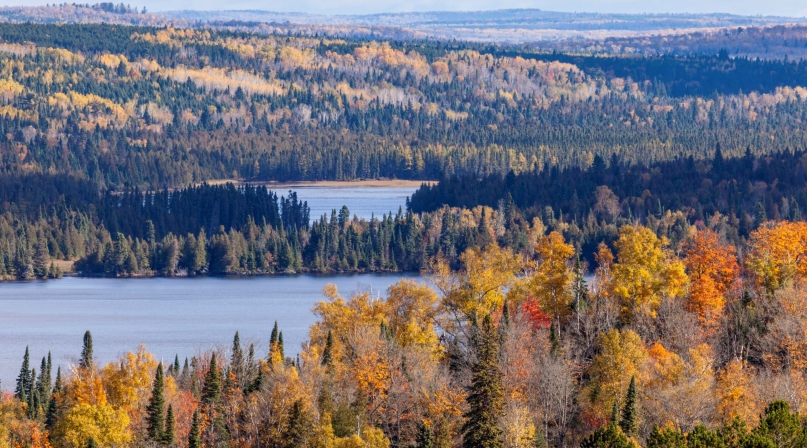Helium find could be a boon to a 82% public lands county in Minnesota

The discovery of a massive helium reservoir in Lake County, Minn. could result in lower property taxes for residents and more jobs and infrastructure for the county, which will be able to fill more party balloons than it knows what to do with to celebrate.
The helium deposit, which is surrounded by public lands, has a concentration measured at 12.4%, a rate roughly 30 times the industry standard for commercial helium. Experts say it could be the largest reserve in North America, and it’s the first helium deposit discovered in Minnesota, a state with no regulations for gas extraction.
“It’s kind of the Wild West in that respect,” said Lake County Commissioner Rich Sve.
The “totally unexpected” helium discovery occurred while a company was drilling for copper-nickel, which is abundant in the area, Sve said. While it might be best known for filling balloons, helium is also critical for medical technology, as it’s needed for MRIs, and is also used by search and rescue teams, NASA and in national defense. Helium is a nonrenewable resource, and last year, NBC News reported that the U.S. was experiencing the fourth in a series of helium shortages since 2006.
A bill introduced by state Sen. Grant Hauschild puts a pause on commercial development until a regulatory framework for extraction is established.
“While this is an exciting opportunity, without a framework, our local communities, our schools and our residents will not see the benefits,” Hauschild said April 4, during the bill’s first hearing in the Senate Environment, Climate and Legacy Committee.
“It’s important to get this right and ensure that our communities in Northern Minnesota receive the net benefits of this newly discovered deposit,” he said.
Geology tests indicate that helium is likely present in St. Louis County, Lake County’s neighbor to the west, as well, and the two counties have consulted with the state, the Department of Natural Resources and the Department of Revenue on the proposed legislation, according to St. Louis County Commissioner Paul McDonald.
“There is some great potential, whether it’s royalties, jobs, you name it,” McDonald said. “It puts us in a good position to be in. The concentration of the find is sort of astronomical in comparison to other helium finds, so it’s very intriguing. It’s very exciting and there’s a lot more work to be done, but initially, it looks very positive for citizens and counties.”
Helium would present a “significant” economic development opportunity and diversification of St. Louis County’s mineral production, according to Julie Marinucci, St. Louis County’s land commissioner and director of the county’s land and minerals department.
“It’s also important that with any developments and land use decisions that we’ve got within the county that we’re always balancing the ability to develop our mineral wealth with ensuring that in that development, we’re doing it responsibly,” Marinucci said. “In a way that is fair and equitable both to the people of St. Louis County and then also the natural landscape that we manage — that we’re protecting the land, we’re protecting the water, and everything is done in a thoughtful way.”
If the bill — which is moving on to the State and Local Government and Veterans Committee — passes, the DNR would be able to require royalties for gas extraction on state-managed lands and set a minimum production royalty of 18.75% gross sale prices.
If it follows Minnesota’s existing structure for collected royalties, 20% would be retained in the state’s minerals management account and 80% would be distributed among the local school district, the local township and the county. Within that 80%, four-ninths would go to the local school district, two-ninths to Stony River Township and the remaining one-third to the county government itself.
The county receiving royalties from the helium deposit could have the potential to reduce property taxes for county residents and create a revenue stream into the county’s general fund, Sve said. The royalties would help offset the county’s levy, along with Payment in Lieu of Taxes dollars the county receives each year from the federal government because of its inability to charge property taxes on federal land.
“If you had a $12 million levy, and you received a million dollars in royalties, that is a million dollars that the taxpayers would not have to pay on their property tax,” Sve said.
The Department of Natural Resources serves as the Trustee for the 2.5 million acres of School Trust Land in Minnesota — public lands specifically designated to support the state’s public education. Interest and dividends from the lands go into Minnesota’s Permanent School Fund, which distributes funds to every public school district in the state.
Almost 80% of the value of the fund comes from minerals, specifically iron ore/taconite leasing and royalty payments, according to Aaron Vande Linde, director of the Minnesota Office of School Trust Lands. If there is helium found on School Trust Lands, the fund would increase.
Because this is uncharted territory for the counties and the state, Sve enlisted the advice of a fellow county commissioner, Lincoln County, Nev. Commissioner Varlin Higbee, on what role a county can play with gas extraction. Sve has also been in conversation with officials in two Colorado counties, Garfield County and Weld County.
“When I was at the [Legislative] Conference at NACo, this was pretty front-page news for us at that time, so I talked to one of the WIR [Western Interstate Region] board members, Varlin Higbee,” Sve said. “I said, ‘What do you know about gas extraction?’ Because it doesn’t have to be helium, and he was really helpful, he filled me in. I was learning about ‘rule of capture’ from him, I was learning about royalties, all these other things.”
While it’s surrounded by public lands, the helium was discovered on a 40-acre plot of private property. Without the regulations the proposed legislation would create, the state, the county, schools and local townships wouldn’t get any of the royalties because of the “rule of capture.”
“Where the extraction point is, where the well is existing right now, there’s all kinds of other property owners around it, so instead of just this little piece, it’s a big bubble,” Sve said.
“And all around that and all through it are all these different property owners. Some of them are private, some of them are public, so think about all of those property owners as the lid of the most delicious milkshake you can think of, but the guy in the middle, the guy right now that has that little well in there, he’s the only one with the straw.
“So, everybody owns that milkshake, but right now, under the rule of capture, if they were going to start extracting, he’s the only one that would benefit, because nobody else has a straw in that lid.”
As it stands now, companies would need to obtain a conditional use permit from the county to begin extraction.
Lake County is in talks with Pulsar Helium, the company set to extract on the land once regulations are established, and the city of Two Harbors to create a helium refinery plant in the county.
Roads are another aspect of infrastructure the county will have to address once regulations are created, Sve said.
“Where they’re at right now is on a forestry road, but it’s not real conducive to running semi-trucks of helium daily out of that site,” Sve said.
“So that is something else that we’ll have to be looking at and engaging with the company, as far as building a road that would hold up to that type of traffic and fulfill that need of transportation.”
The helium finding is a reminder of how important it is for local governments to be aware of the potential its public lands hold, especially a county like Lake County, which is 82% public lands, Sve said.
“A lot of people when they think public lands, they think recreating, hunting, fishing — you pick your sport — trails and waterways,” Sve said.
“But there’s this other component of a working forest, which the Superior National Forest, where this find was, is a working forest, so it just shows that public lands have really a broad range of use and importance into our communities.
“And this is just kind of an offshoot of it, that we now have the potential for a great revenue source that will benefit local government and will benefit the taxpayers of Lake County and the school district and the students of our county.”
Related News

Podcast: Talking with Public Lands County Leaders, Part V
Mariposa County, Calif. Supervisor Miles Menetrey and Eagle County, Colo. Commissioner Kathy Chandler-Henry discuss the coalition building necessary for counties to succeed when much of their land is managed by the National Forest Service and National Park Service.

County Countdown – September 24, 2024
Every other week, NACo's County Countdown reviews top federal policy advocacy items with an eye towards counties and the intergovernmental partnership.

Public lands county leaders show vision, experience
Following a busy day of Capitol Hill meetings, county public lands officials shared their insight on shared stewardship, the nature of public lands county economies and the direction the National Center for Public Lands Counties will take.
Advocacy
U.S. House Natural Resources Committee unanimously supports Public Land Renewable Energy Development Act

